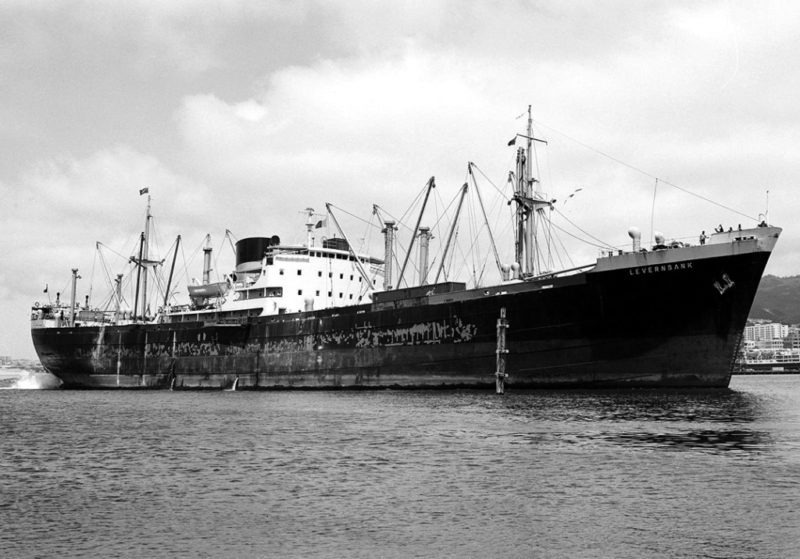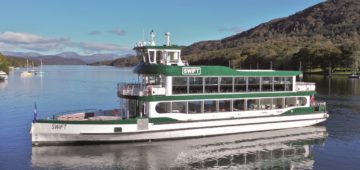
The Levernbank was built at Harland and Wolff and delivered to her owners, the Bank Line Ltd., in mid-1961. The ship was a late derivative of the Cloverbank Class.
Being mid-way through my apprenticeship and following 6 weeks home leave in Hong Kong, I joined her at Yau Ma Tei anchorage on 1st January 1963. At this juncture, the ship was relatively new and I distinctly recall thinking to myself what a picture she looked as my launch approached the accommodation ladder. I had been informed by the Bank Line office in Hong Kong that the ship would be engaged more or less permanently in the Orient-Africa Liner Service. This suited me well, because being a Hong Kong resident it meant regular calls at my home port.
I was also pleased to learn that the crew was Hong Kong Chinese, in fact exactly the same crew I had sailed with for 16 months on my previous ship the Weybank which had been sold late the previous year in Hong Kong for continued trading, and renamed Silver Moon.
At the time of my joining the Master was Captain Holland, whom I found to be a true gentleman. He later handed over command to Captain Louis Wigham, who was subsequently relieved by Captain Williams. I served under all three Masters for the duration of my time onboard until completing my indentures and signing off, again in Hong Kong, on 6th October 1964, a voyage of some 22 months. However, I must confess, the prolonged period was no real hardship since I was regularly calling at my home base and the scheduled run was fantastic. Very few wanted to leave or sign off the ship and a number of the officers requested to extend their time onboard when crew changes were planned. The result was, having spent very little time ashore whilst an apprentice, I completed my sea time quite early at the age of 19 years and 10 months.
The ship itself was easy to work and she always performed well. She was relatively fast (16 knots) but we generally averaged about 15 knots whilst in the OA Liner Service, in order to maintain a schedule. Accommodation was comfortable and being senior apprentice I had my own, good sized cabin, located on the port side of the boat deck. Two other deck apprentices were situated in an adjacent double berth cabin, which was separated from my cabin by the apprentice’s study. The bulkheads were all adorned with light teak veneer and furnishings such as curtains, bed and settee covers, tastefully colour co-ordinated.
The Chinese crew were great and good to work alongside, especially so because I was able to converse with them in their native Cantonese, which I had been taught as a kid. The ship was a good feeder with decent variety, no shortages of provisions, because, due to our frequent port calls, we were always able to top-up with fresh produce. Obviously we had our weekly Chinese extravaganza which was highly relished by all, but the cooks also produced some mighty curries which always went down well. I do not recall hearing a single complaint about the quality or quantity of food during my entire time onboard.
The mates and engineers were all Brits, mostly Scots or Geordies, except for our long serving chief engineer who was a Kiwi. Also, one of the electricians was South African, from Durban.

The run was great, if not a little hectic at times. Departing Hong Kong (which served as the Company’s Regional Head Office and Far East Hub) we would proceed northbound to Taiwan after which we would spend one month calling at various ports around the Japanese coast. Southbound, we would proceed to Hong Kong, with prior calls at Manila or North Borneo if cargo inducement so required.
We usually spent 3-5 days at Hong Kong loading before proceeding southwards to Bangkok, Singapore and Port Swettenham. By the time we sailed from Port Swettenham the ship was generally well laden.
The voyage across the Bay of Bengal and Indian Ocean to Mauritius (and occasionally Reunion) was the longest stretch. Dar-es-Salaam was our next port followed by Beira, Lorenzo Marques, Durban, Port Elizabeth, East London and Cape Town. The port of Capetown was our southern limit, where we started to backload progressing our way back up the same African coastal ports, with additional load ports of Mtwara, Tanga, Zanzibar (usually high revenue cargo-chests of cloves or tea and bags of coffee) and Mombasa, on the northbound sector.
We always seemed to spend a decent number of days loading at Mombasa. From Mombasa it was either direct to Port Swettenham or with an intermediate call at Mauritius (usually to load bagged sugar). From Port Swettenham we would proceed to Singapore and Bangkok, prior to calling at Hong Kong and Taiwan before spending another month traversing the Japanese coastal ports. We did not use our deeptanks for liquid cargoes during my tenure on board, but rather they were usually full of rice, latex, packs of timber or bagged sugar or coffee. Occasionally we might fill deeptanks with bulk maize for Japan, from one of the African ports. Tweendecks were usually reserved for mixed general cargo, which were carried in abundance, whilst the bagged or more bulky cargo was stowed in the lower holds.
I well recall we would occasionally load pallets of stinking cow hides, mainly from East African ports for Singapore. Smelling so awful they were usually loaded in one of the after hatches, segregated as much as possible from other cargo to avoid tainting due to their odour. Shipping the cow hides was the only downside to the round trip, and we always disliked loading them.
Nevertheless, going by the volume of cargo lifted, both north and southbound, it must have been a profitable enterprise for Bank Line because the cargo plan was like ‘Liquorice Allsorts’ because there being so many different parcels of cargo, large and small. The cargo plans produced by the 2nd Mates were true masterpieces. Obviously this was before the onset of containerisation. The ship was also fitted with reefer lockers which were always in demand, especially when northbound from South Africa. We apprentices were always tasked with separating and marking the various parcels, which were numerous in number.
Three other Bank Line ships were regularly engaged in the OA Liner Service, namely Garrybank, Riverbank, Cloverbank.
Many friendships were forged with us being on a regular service over a prolonged period and the crew became well known, gaining ‘squatters rights’ at many of the pubs, bars and hotels and sometimes places of less repute along the route. The result was that few of the officers had much saved when payoff time arrived. It did not matter to us apprentices because we didn’t earn enough to save much anyway.

A great ship engaged on a great run. I was genuinely sad to leave the vessel when the time eventually arrived and quite shaken when I learned of her loss at Matarani in 1973. What a sad ending for such a graceful lady.



Comments
Sorry, comments are closed for this item